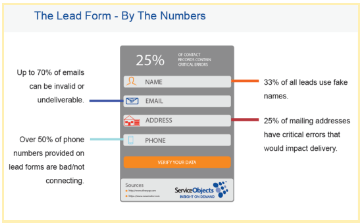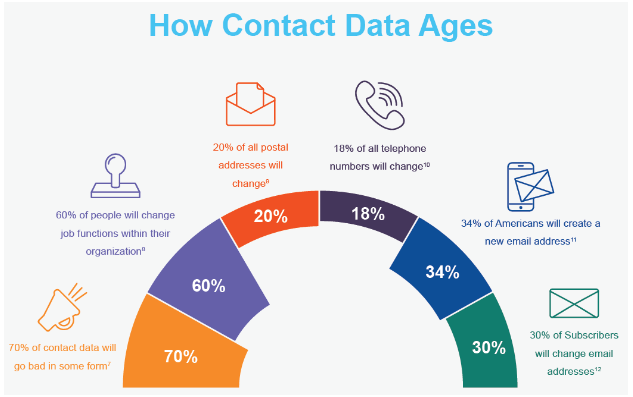Bad Contact Data Quality
Your leads and customer contact records are the lifeblood of your company. Did you know that, according to SiriusDecisions, 25% of your customer data is inaccurate? If you haven’t already, now is a great time to take a look at the hard and soft costs associated with bad contact record data.
What if I told you that no matter how expensive and efficient your software and systems are, they will ONLY work to full capacity if the contact data within them is properly managed and maintained for accuracy. We’re talking about implementing quality assurance and data governance policies.
Here are the cold, hard facts: without some sort of data governance policy in place, you will have corrupted contact records. Consequently, you need to understand exactly how
bad contact data is impacting your marketing campaigns so you can fix the problems and get on with business.
Mistakes Happen
Plain and simple, there are a number of places where errors happen. When you look at a lead form, there are multiple fields to fill out. It’s here at the initial capture point where simple, careless or fraudulent entries occur.

And, over the course of one year you can expect your contact records to become out of date or obsolete.

These underlying problems, both intentional and unintentional, create a perfect storm that will erode the foundation of your company’s contact records.
Facing the Consequences
You’ve probably done the math and realized that if 25% of your customer data is incorrect, then 25% of your marketing efforts will result in lost opportunities, compromised reporting, and lost revenue. Clearly, increased company costs and lost revenues are major concerns that result from poor data quality. However, there is also a domino effect with soft costs that is not as apparent. Here are just some of the areas where bad contact data costs you money:
- Decreased confidence and productivity from your sales teams
- Increased costs for Lead & Customer Acquisition, Marketing Automation, and CRM fees.
- Misspent marketing labor costs
- Increased risk of regulatory fines (e.g., Do Not Call compliance, SPAM traps).
- Increase in Customer Care efforts (resulting from unhappy customers)
Now imagine these soft costs piling on top of each other, adding up over time. Eventually, you will see large-scale impacts that, if left alone, might prove challenging to overcome. In fact, two of the most critical are maintaining your employee and customer satisfaction.
To the extreme, employees will leave if they can’t rely on their leads to make their sales quotas and commissions. And, if your customers are consistently exposed to a bad experience, like delays in shipping or poor customer service, they will find a more reliable company to do business with. In the long run, bad contact data quality undermines relationships and weakens “trust”, which is extremely difficult to gain back once it’s been breached.
It’s quite overwhelming to think that ALL of your business decisions are based on information received from captured data. The bad news is: contact data quality issues cannot be avoided, BUT, the good news is:
they can absolutely be managed and improved! In fact, Data Quality Experts, such as those at
Service Objects, offer a number of services and tools that will correct and maintain contact records.
The bottom line is this: You want your contact data to be an asset NOT a liability. It is the cornerstone of your marketing efforts and should be taken care of and nurtured. Looking closely at where and how bad contact data may be affecting your company will help you take steps towards sustained contact data quality improvement.
If you’d like to learn more about the impacts of poor data quality, please download our white paper,
“Marketing with Bad Contact Data: A Recipe for Disaster”
This article was written by Rob Manser, Demand Generation Manager at Service Objects, Inc.
